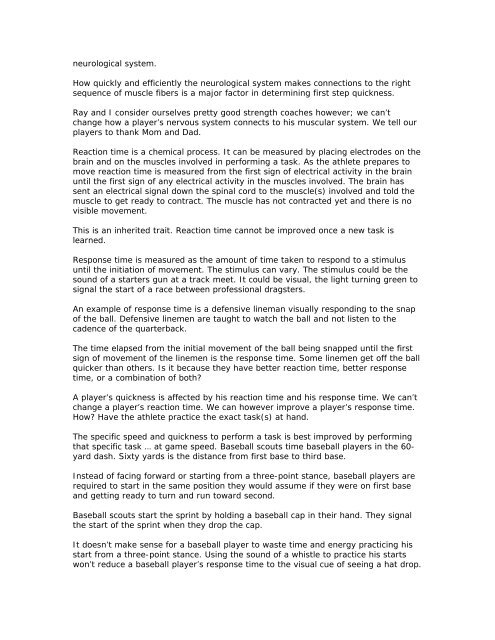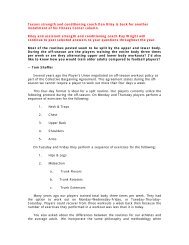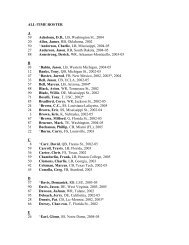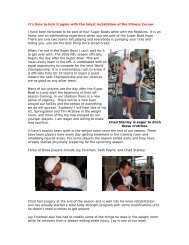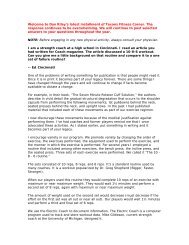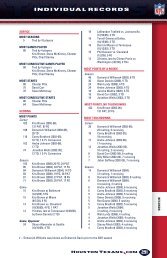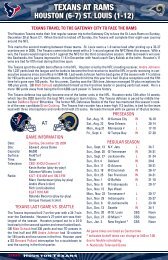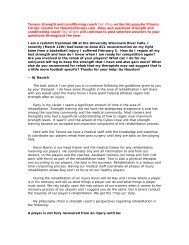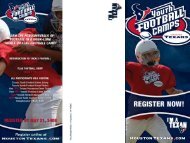Texans strength and conditioning coach Dan Riley has compiled a ...
Texans strength and conditioning coach Dan Riley has compiled a ...
Texans strength and conditioning coach Dan Riley has compiled a ...
You also want an ePaper? Increase the reach of your titles
YUMPU automatically turns print PDFs into web optimized ePapers that Google loves.
neurological system.<br />
How quickly <strong>and</strong> efficiently the neurological system makes connections to the right<br />
sequence of muscle fibers is a major factor in determining first step quickness.<br />
Ray <strong>and</strong> I consider ourselves pretty good <strong>strength</strong> <strong>coach</strong>es however; we can’t<br />
change how a player’s nervous system connects to his muscular system. We tell our<br />
players to thank Mom <strong>and</strong> Dad.<br />
Reaction time is a chemical process. It can be measured by placing electrodes on the<br />
brain <strong>and</strong> on the muscles involved in performing a task. As the athlete prepares to<br />
move reaction time is measured from the first sign of electrical activity in the brain<br />
until the first sign of any electrical activity in the muscles involved. The brain <strong>has</strong><br />
sent an electrical signal down the spinal cord to the muscle(s) involved <strong>and</strong> told the<br />
muscle to get ready to contract. The muscle <strong>has</strong> not contracted yet <strong>and</strong> there is no<br />
visible movement.<br />
This is an inherited trait. Reaction time cannot be improved once a new task is<br />
learned.<br />
Response time is measured as the amount of time taken to respond to a stimulus<br />
until the initiation of movement. The stimulus can vary. The stimulus could be the<br />
sound of a starters gun at a track meet. It could be visual, the light turning green to<br />
signal the start of a race between professional dragsters.<br />
An example of response time is a defensive lineman visually responding to the snap<br />
of the ball. Defensive linemen are taught to watch the ball <strong>and</strong> not listen to the<br />
cadence of the quarterback.<br />
The time elapsed from the initial movement of the ball being snapped until the first<br />
sign of movement of the linemen is the response time. Some linemen get off the ball<br />
quicker than others. Is it because they have better reaction time, better response<br />
time, or a combination of both<br />
A player’s quickness is affected by his reaction time <strong>and</strong> his response time. We can’t<br />
change a player’s reaction time. We can however improve a player’s response time.<br />
How Have the athlete practice the exact task(s) at h<strong>and</strong>.<br />
The specific speed <strong>and</strong> quickness to perform a task is best improved by performing<br />
that specific task … at game speed. Baseball scouts time baseball players in the 60-<br />
yard dash. Sixty yards is the distance from first base to third base.<br />
Instead of facing forward or starting from a three-point stance, baseball players are<br />
required to start in the same position they would assume if they were on first base<br />
<strong>and</strong> getting ready to turn <strong>and</strong> run toward second.<br />
Baseball scouts start the sprint by holding a baseball cap in their h<strong>and</strong>. They signal<br />
the start of the sprint when they drop the cap.<br />
It doesn’t make sense for a baseball player to waste time <strong>and</strong> energy practicing his<br />
start from a three-point stance. Using the sound of a whistle to practice his starts<br />
won’t reduce a baseball player’s response time to the visual cue of seeing a hat drop.


